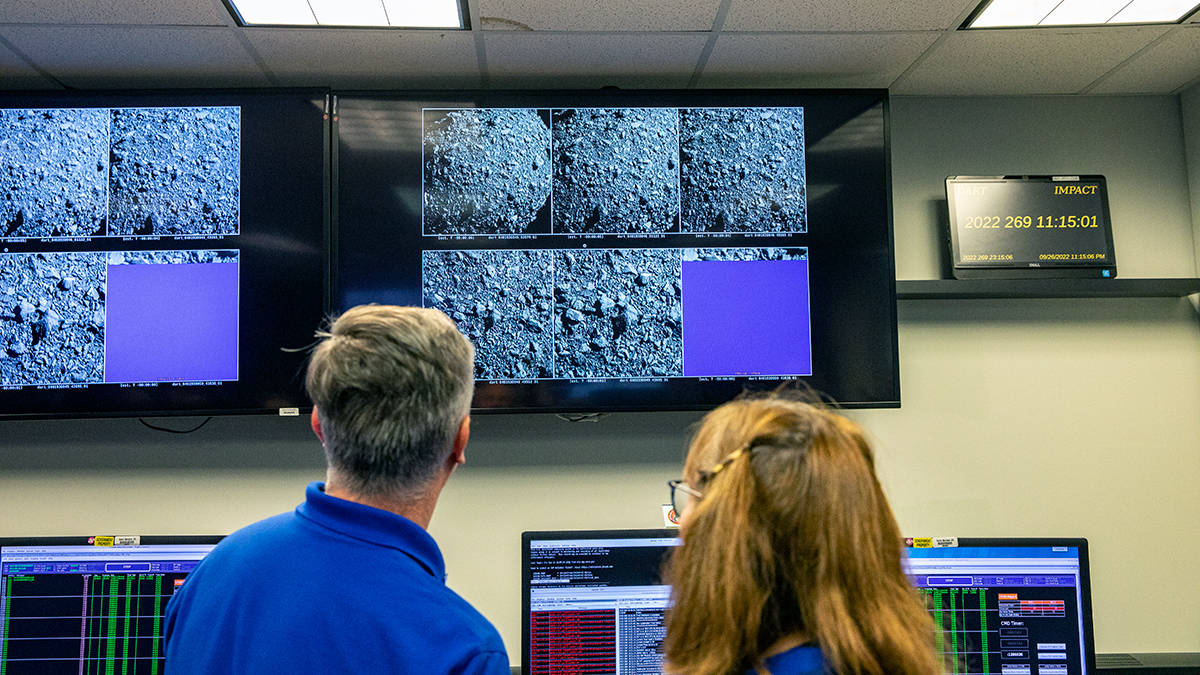Two years ago, NASA’s Double Asteroid Redirection Test (DART) mission successfully set a roughly 580-kilogram impactor on a collision course with a near-Earth asteroid called Dimorphos. The resulting impact significantly altered Dimorphos’s orbit around its partner asteroid, Didymos, demonstrating that humans perhaps have more than a fleeting chance at deflecting future asteroids that may be on a crash course with Earth. Researchers have now mined a trove of high-resolution imagery of both Dimorphos and Didymos collected by the DART mission to better understand the geological history of this binary asteroid system. They published their findings in Nature Communications.
Beyond Planets and Moons
Sun-orbiting asteroids, which tend to be small but number in the millions, have tales to tell about the solar system.
Imagine an object in the solar system. Chances are good a planet or moon popped into mind. But Sun-orbiting asteroids, which tend to be small (their total combined mass is less than that of Earth’s Moon) but number in the millions, have tales to tell about the solar system, too. After all, they’re the literal relics of its earliest days.
Researchers often study asteroids indirectly by analyzing bits of them that make their way to our planet in the form of meteorites. But many of the very properties that contribute to Earth’s habitability—our planet’s relatively thick atmosphere, abundance of water, and propensity for erosion, for instance—can also wreak havoc on meteorites by weathering them and essentially erasing their chemical imprints of the early solar system.
However, sending a spacecraft to visit an asteroid provides a treasure trove of high-resolution data that far supersede observations made by even the most powerful ground- or space-based telescopes. That’s what happened in 2022, when an international team of researchers wrapped up the DART mission by intentionally crashing a spacecraft into Dimorphos and obtained a plethora of close-up imagery of the asteroid and its larger companion in the process.
Boulders of Unusual Size
Those images, with spatial resolutions of just a few centimeters in some cases, have shed new light on the geology and evolution of this binary asteroid system. For starters, researchers have discovered that numerous large boulders are scattered over Didymos’s surface. The largest measures roughly 160 meters across, or about 20% of Didymos’s diameter. For comparison, the height of Mount Everest, Earth’s tallest peak as measured above sea level, is less than 0.1% of Earth’s diameter. So although the boulders on Didymos might not be large by Earth standards, their size relative to their host body is decidedly otherworldly, said Olivier Barnouin, a planetary geophysicist at the Johns Hopkins University Applied Physics Laboratory in Laurel, Md.
“It’s basically made of a lot of rocks of different sizes.”
That discovery suggests that Didymos is a rubble pile asteroid, which means it’s an agglomeration of rocks held together very loosely by gravity, said Barnouin, who led the new study. “It’s basically made of a lot of rocks of different sizes.” Dimorphos exhibits a similar array of unexpectedly large rocks on its surface and is probably a rubble pile asteroid as well, the team concluded. Spacecraft visits to asteroids such as Bennu and Ryugu have shown that they’re rubble pile worlds as well.
The close-up images also revealed that Didymos’s surface is far from uniform—the asteroid’s equatorial region, which tends to be lower in elevation, is generally smoother than its higher-latitude regions, which are higher in elevation. Those trends are consistent with fine-grained material tumbling down from Didymos’s highlands to its lowlands. “Stuff is coming down from the mountains to the valleys,” Barnouin said.

Decidedly Unsticky
By also looking at how rocks were oriented on sloped surfaces on Dimorphos, the researchers were able to estimate the so-called surface cohesion of the asteroid. That property refers to how strongly stuck together something is, said Barnouin, and the value the team inferred was extremely low. “There’s not a lot of stickiness between rocks,” Barnouin said.
That cohesive force between Dimorphos’s constituent rocks is, in all senses, out of this world, said Cristina Thomas, a planetary astronomer at Northern Arizona University in Flagstaff who coordinated ground-based observations of the DART impact in 2022 but was not involved in the new research. “It’s really outside of the regime of how we think about our lives on a day-to-day basis,” she said.
Barnouin and his colleagues also calculated how frequently impact craters of various sizes appeared on Didymos and Dimorphos. On the basis of those crater size-frequency distributions, the team inferred that Didymos was several tens of times older than Dimorphos. That result, and the evidence of possible boulder tracks spotted on Didymos indicative of moving rocks, suggests that Dimorphos might have been formed from material sloughed off of Didymos.
Spinning and Losing Control
Boulders and finer-grained material could have literally slid off of Didymos in the past and then coalesced to form Dimorphos, Barnouin and his team concluded. Today, Didymos spins on its axis once every 2 hours and 15 minutes. If the asteroid had spun a bit faster in the past—entirely possible due to forces imparted by sunlight—material would have been readily sloughed off into space, the researchers calculated. Furthermore, Barnouin and his collaborators estimated that only a relatively small fraction of Didymos’s volume would need to have been displaced. “Less than 1 meter of material across the surface can account for the volume of Dimorphos,” said Barnouin. “You don’t need a lot of material.”
It will be possible to look for evidence of that mass displacement when the European Space Agency’s Hera mission revisits Didymos and Dimorphos in 2026. Hera, primarily a planetary defense mission, will be focused on measuring the shape of the crater created by the DART impactor. But instruments on board the car-sized spacecraft should also be able to spot where material sloughed off of Didymos, said Barnouin. “That’s something that Hera should be looking for.”
—Katherine Kornei (@KatherineKornei), Science Writer

